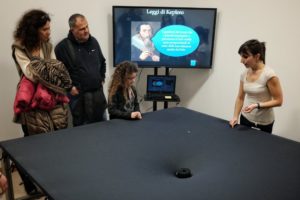The EPS Young Mind Section of Rome was very productive in 2017 with the “Let’s make fun with science: Sun, light and colored shadows” project, aimed at discovering the concepts of light and colors through different experiments. This project has been partially founded by the 2017 Activity Grant and has been described in the last January 2018 Report.
In the first months of 2018, we ideally carried on this journey through the project “Let’s make fun with science: colors and soap bubbles”. In fact, even if apparently they are very simple, soap bubbles are the realization of many physical phenomena all together. First of all, their shape allows to explore the concept of surface tension of liquids. But even more, the colors appearing and disappearing on their surface force to wonder about the nature of light and colors. In particular, a deep understanding of how soap bubbles work requires the knowledge of many concepts related to waves, such as the Sun spectrum, the frequency, the wavelenght, but also interference and diffraction. For this reason, soap bubbles can be used at different levels: to create a fun activity for kids, to make physics students wonder about optics and Sun spectrum, and to give high school teachers a way through which they can explain interference to their students. The EPS Young Minds Section of Rome have tried to develop each of this ways.
We began with kids. During the event “Eyes on the Moon”, hosted by the Physics Department of Roma Tre University on February 23th, we used buckets, dishwashing liquid and straws in order to give children the opportunity to create their own soap bobbles of different sizes and shapes. With older people, including high school students, we organized afteroon activities adding a more detailed explanation of what happens in a soap film drawing optical waves on cardstocks, and using simple spectrometers to show the Sun spectrum. Moreover, with a more selected public, such as high school teachers or adults, we tried to explain what happens with a soap film on a can. In fact, if you try to make a soap film on one side of a can, and try to arrange it vertically, you will see that strips of different color will form. Their colors will alternanate, providing a great way to see, in practice, destructive and constructive interferences of waves.
At the end, the “Let’s make fun with science: colors and soap bubbles” project had more than 300 participants between primary, secondary schools students teachers and general public.












